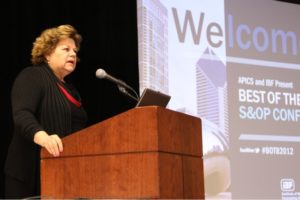To drive S&OP excellence, we need to be bilingual. Companies need to speak both the language of “volume” and “currency.” “Currency” is the lingua franca for discussions
with finance, but “volume” is necessary to determine the “feasible plan.”
Pat Bower, Senior Director of Supply Chain Planning, Combe International
During the cold and snowy weeks of January, Anish Jain, Managing Director of the Institute of Business Forecasting (IBF), Greg Schlegel, currently Professor at Lehigh University on Risk Management, and I carefully constructed the content for the APICS/IBF Best of the Best Sales and Operations Conference. The conference was held in Chicago this past week. The preparation was a cadence of week-after-week phone calls in a period of great personal uncertainty. I would wake up for 8:00 a.m. phone calls after tossing and turning during the night wondering if I should start Supply Chain Insights . I wore out the bed each night worrying. These calls were sandwiched between discussions between lawyers, web designers, and accountants. I was sometimes late for the meetings because I was so engrossed in writing my book that I forgot to look at the clock. I was deep into Chapter 2 of the book, Bricks Matter (now can be pre-ordered on Amazon ). I was trying to figure it all out. Starting a company and writing a first book is not for the meek and mild. This all now seems SO long ago. So much has changed for me; however, this week, I got to see the “fruit of our labors” of these winter calls. Over 300 supply chain professionals attended the conference.
 During the opening session, I had the opportunity to facilitate the morning panel. I presented some of the data that IBF/APICS compiled in a March study, and I was lucky to have a great panel to share their insights on the data. The panel consisted of Alan Milliken, Supply Chain Educator Specialist at BASF; Jonathon Karelse, VP Corporate Development & Strategic Planning, Wholesale Tire International; Judy Nolan, Forecast Improvement Manager at Rolls-Royce; and Pat Bower, Senior Director of Supply Chain Planning at Combe International. I liked the panel because they were all senior supply chain leaders from VERY different industries, and they were not afraid to state their opinions. I like people with a point of view and I love diversity.
During the opening session, I had the opportunity to facilitate the morning panel. I presented some of the data that IBF/APICS compiled in a March study, and I was lucky to have a great panel to share their insights on the data. The panel consisted of Alan Milliken, Supply Chain Educator Specialist at BASF; Jonathon Karelse, VP Corporate Development & Strategic Planning, Wholesale Tire International; Judy Nolan, Forecast Improvement Manager at Rolls-Royce; and Pat Bower, Senior Director of Supply Chain Planning at Combe International. I liked the panel because they were all senior supply chain leaders from VERY different industries, and they were not afraid to state their opinions. I like people with a point of view and I love diversity.
There is nothing worse than a BORING panel, and they kept it lively. Judy started the panel stating that she “…was not going to be giving away any cars.” Rolls-Royce now primarily makes engines. She shared insights on the role of forecasting in S&OP in an organization where everyone had been in their jobs for at least 25 years. At Rolls-Royce, they struggle to accurately forecast routables (engines that are refurbished as part of the wear cycle). Alan, with his southern drawl and years of experience, clearly articulated the journey of S&OP at BASF, and pinpointed the difference between the process owner (which he thought should be supply chain) and the business owner (which he thought should be the managing director of the profit center). He emphasized the need for well-defined governance and education. During the discussion, he shared insights on the evolution of their S&OP processes stating that there were many S&OP processes (more than the average of six) and that the least mature processes are in Asia. Jonathon had some great insights on driving forecast accuracy process improvements. He works in a distribution environment with lumpy demand and has crafted some unique, and very successful, techniques to improve the process. (I would encourage all readers of this blog in distribution industries to download his presentation from the IBF website.) Pat, with many years of consumer products experience, is quoted at the top of this blog. He is adamant that supply chain is business and that the supply chain team needs to be bilingual. He pushes back that the new hype on Integrated Business Planning (IBP) is really an acronym for “I’ve Been Played.” He believes that S&OP has always been about the language of business and that the key to successful supply chain leaders is the ability to speak the language of the business. He thinks that the new IBP acronym is driven by consultants trying to sell new services.
As part of the planning committee for a conference, you get to help with the selection of speakers. To help the committee, I reached into my Rolodex and begged past clients to tell their stories. This took me about six weeks. However, as I sat in the audience and heard their stories, I was proud. Each had driven a very different S&OP transformation, but each was one to be proud of. This is what I heard as I smiled a proud smile:
VF Corporation. Kerry Middlemas, currently Director of Operations at Nautica, called me two years ago. She had seen me on a video talking about change management in S&OP, and she invited me to speak to her five coalitions of different businesses on the evolution of S&OP processes. They were attempting to define how they should design the process that could be applied to VERY different businesses. I wanted to help. Kerry is the age of my daughter and she was tackling a big task.
The VF Corporation is a coalition of VERY different businesses. The goal was to drive a common process for S&OP across brands with very different rhythms and cycles. This included brands like 7 For All Mankind, JanSport, Rustler, Lee Jeans, Nautica, Wrangler Jeans, Timberland, and Vans.
Each company that I work with has their own set of strengths and biases. As Kerry commented in her presentation, “The VF Corporation has a strong financial orientation with a laser focus on inventory management.” I smiled remembering the discussions. She went on to say, that “they lack an understanding of forecasting, they have struggled with the fit of SAP systems for apparel.” I remembered back. The company has strong leaders and, prior to the meeting, each believed that their past experiences, at their prior companies, defined S&OP excellence. The discussions were a bit contentious as we struggled together to define a new vision.
It had been a year since I had connected with the team, and I was anxious to hear Kerry’s story. What impressed me the most about Kerry’s presentation was to hear these same leaders that gave me such a hard time talk via web clips endorsing their new common process that had been tailored slightly to support different businesses. I was excited to hear the energy in their voices and their business results. It was a strong testimonial to a central resource being able to span multiple businesses to drive a common understanding to implement an S&OP process to improve business results.
Sonoco Products. I have worked with the Sonoco Products team off and on for the last seven years. Five years ago I met Keith Holliday, then the newly-hired Director of Supply Chain and Operations. He had asked for a strategy session focused on how to build a demand-driven value network. I co-presented the session with Debra Hoffman, one of my close friends currently at Gartner Group. We discussed supply chain metrics and the principles of demand sensing and shaping. At the time, it was my “standard schtick.” While they easily gravitated to Debra’s content, they struggled with mine. They pushed back. They said that, “…they liked Debra, but they were not sure about me.” They laughed in a good natured way.
The demand-driven content seemed so foreign to the group. But, unlike many groups that hear and disregard my content, they joked and discussed it with me. They did not fold their arms and pretend to understand. Their question was framed as, “How could a company that manufactured packaging materials for consumer goods manufacturers apply the concepts of demand shaping?” As we discussed the concepts, they struggled with specific realities of their business: they had little control over price, innovation was strongly linked to their upstream clients’ demands and that the concepts of trade promotion management did not apply to their industry. At that time, they were very supply driven. The focus was on asset utilization. So, out of desperation, I talked to them about how they could use S&OP to sell excess capacity. I challenged them to stimulate demand to maximize machine loading. And, sure enough, Keith did it! And, at the event, he told his story. He focused on how he overcame change management issues to become demand driven.
In the chart below, you can see that Keith and the team were able to drive revenue growth while maintaining inventory levels. I contrast his progress to that of a similar company that I worked with in the same period, Owens Illinois, and the industry average.  He has reason to be proud. The S&OP process helped them to navigate the economic downturn and is now well accepted as an important process in the organization. The supply chain group has gained stature due to their ability to help the business deliver real and meaningful results.
He has reason to be proud. The S&OP process helped them to navigate the economic downturn and is now well accepted as an important process in the organization. The supply chain group has gained stature due to their ability to help the business deliver real and meaningful results.
Kimberly-Clark. I used to hate the flights to Neenah, Wisconsin to work with Kimberly-Clark. Invariably the many strategy sessions over six years were always scheduled in the middle of winter. The heater in my hotel room was never up to the task of keeping the room warm in the dead of winter and my boots were never tall enough to avoid getting snow in them crossing the parking lot. As a result, I spent many a day in Kimberly-Clark conferences discussing the principles of becoming demand driven with wet feet to a full conference room. However, they were great students. This week, Scott DeGroot, Director of Customer Supply Chain Strategy’s presentation at the Best of the Best event, was a great reinforcement to why the journey to become demand driven matters. Scott focused on customer collaboration in S&OP.
Scott stood in front of the group, put his shoulders back, and said, “The supply chain is not just about cost. It is about value. Our goal is to deliver $300 million in revenue through supply chain activities with customers this year.” He then went on to describe what it looked like. They had made so much progress. Through the implementation of downstream data projects, short-term forecasting technologies and trade promotion optimization, they now have a better forecast of what is going to sell in the store than any retail partner can give them. I gasped. They had made so much progress over the past five years. While others have talked about outside-in processes, they have built them. I cannot wait to get their Annual Report to publish their results. Congrats to the Kimberly-Clark team!
 My Take
My Take
Earlier in the week, I was at a trade promotion conference and I had commented to a friend that, “… I was unsure why I did this. I fly to conference after conference, feverishly write on my book and blogs, finish research project after research project, only to talk to teams that struggle to understand these new different concepts. Progress is slow, and I am impatient. It is like watching paint dry.”
As I zipped my suitcase to leave Chicago, I had answered my own question. I know why I do this. The answer is clear. I do it because these concepts matter. Supply chain excellence helps companies to drive greater value.
So, to wrap this up, I want to thank each of the panelists that helped me in the morning of the first day of the Best of the Best conference. I think that you did a great job with very little notice. I appreciate your flexibility and experience.
I also want to extend congratulations to Kerry, Keith and Scott. I appreciate each of them taking the time to share their stories. I am PROUD of each of your case studies. I think that they truly exemplified the best of the best!
This week, I continue my journey speaking to clients on market-driven supply chain concepts. I am re-writing chapters one and two of the book to accommodate company case study requests. The book is chock-full of case studies and review cycles are slower than I would like. I find that companies with positive case studies eagerly sign off while companies that have stumbled forward, learning from their failures, struggle to give approval. This will all soon be history when I breathe the clean smell of a freshly printed book that I have worked so hard on. I yearn to hold it in my hands. Like the preparation for this conference, it will soon happen.
(Currently, the book can be ordered on Amazon. And, if you do, please mark that you would like to have it in the Kindle edition. They are trying to assess readership.)






